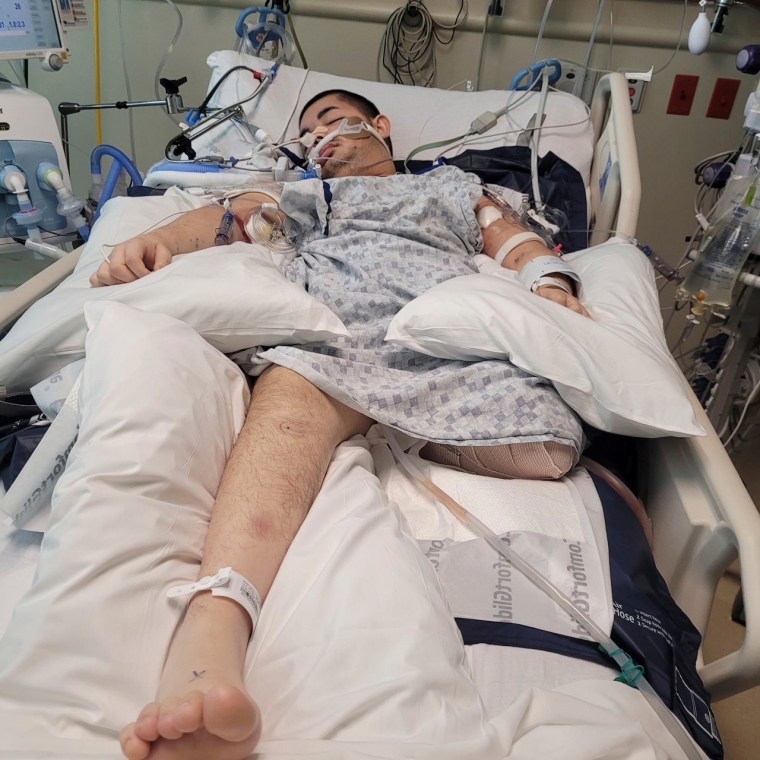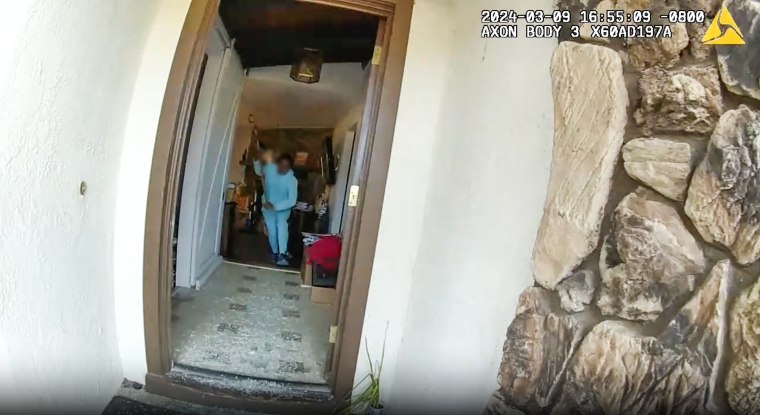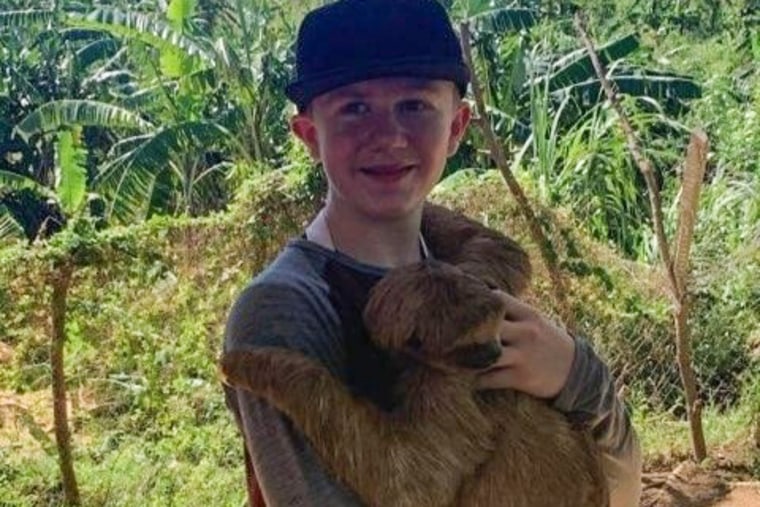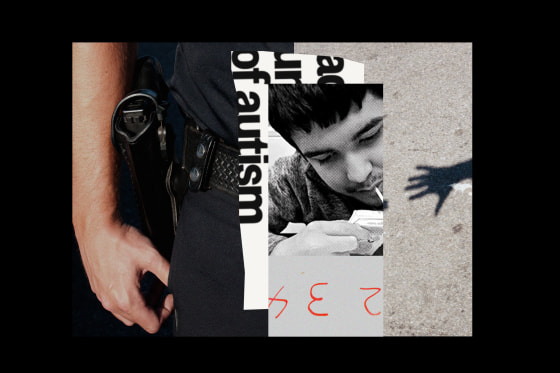When police opened fire on Victor Perez, the autistic, nonverbal 17-year-old with cerebral palsy was experiencing a mental health crisis. Advocates say his death reflects a potential for violence that people with disabilities, in particular, can experience when encountering police.
Perez’s death is part of a much larger pattern, explained Zoe Gross, director of advocacy for the Washington, D.C.-based Autistic Self Advocacy Network, a group run by and for people with autism. Police with little awareness of autism are sometimes too quick to act.
Pocatello, Idaho, officers shot Perez nine times within seconds of arriving at his home, according to the law firm representing Perez’s family. The Latino teenager was on the other side of a fence when officers repeatedly told him to drop the knife as he was moving toward them. He was in the midst of a mental health crisis, his aunt Ana Vazquez told NBC News. She added that while he was holding a knife, the family did not see him as a threat. He died last week, several days after being shot.

It is not clear what, if anything, went wrong in Perez’s case and if circumstances could have turned out differently had the officers received more training. But advocates said the situation highlights a broader lack of understanding when police encounter people with disabilities or those experiencing mental health crises.
There is no federal or nationwide system collecting data on how often people with disabilities are injured or killed by police, but there have been several cases during recent years. Biases against Black and Latino people can also play a role in the way police react, Gross said.
Research shows that people with autism and other developmental disabilities are more likely than others to have contact with the police. And experts say that some autistic behaviors — such as involuntary movements or not responding to commands — could be misinterpreted by police as suspicious or dangerous.
Melissa Sreckovic, associate professor of education at the University of Michigan-Flint, helps train police officers in how to interact with people with autism. “The officers may not understand what the autistic individual is saying, and the autistic individual may not be able to comprehend what the officers are saying,” she said, noting that in many cases, it’s like two people speaking completely different languages.
At least 12 states — not including Idaho — require police training on autism spectrum disorder, according to the National Conference of State Legislatures. Autism affects 1 in 36 children, according to the Centers for Disease Control and Prevention. It’s unclear whether the officers in Pocatello had attended such a training and a request for comment was not returned.
The Pocatello Police Department’s policy manual does not specifically address people with autism, but it describes how officers may have to deal with crisis intervention. A “crisis intervention team” made up of officers, communications operators and civilian employees can respond to calls, the manual says, and an alternative tactic such as de-escalation can be used “when circumstances reasonably permit.”
“Officers should consider that taking no action or passively monitoring the situation may be the most reasonable response to a mental health crisis,” the manual says.
There are also policies for officers in “use of force” situations. Officers must weigh the “immediacy and severity” of a threat, the effects of suspected drug or alcohol use, the proximity of weapons and “the individual’s ability to understand and comply with officer commands,” according to the manual.
The manual also says that deadly force is justified when officers are protecting themselves or others from imminent bodily harm or death. The department is supposed to utilize a “use of force training coordinator” who holds periodic training on defensive tactics. It’s unclear if the officers in this case received that training.
Video from a body camera worn by responding officers was voluntarily released by the city of Pocatello on Thursday. When police approached Perez, he was separated from them by a chest-high chain-link fence. In the video, one officer is heard shouting “drop the knife” multiple times before firing at Perez. The footage shows there were about 16 seconds from the moment police arrived until shots were fired.
The Pocatello Police Department did not respond to requests for comment.
For many advocates, Perez’s killing called to mind other examples of young people with autism who have been killed by police. Ryan Gainer, 15, was killed in March 2024 after charging toward a San Bernardino County sheriff’s deputy while holding a 5-foot-long garden tool.

Deputies were responding to a 911 call from the home that the teen had been “actively assaulting family members” and damaging property.
After the shooting, San Bernardino County Sheriff Shannon Dicus said in a statement, “Our social safety net for those experiencing mental illness needs to be strengthened.”
In February, Chase de Balinhard, a 15-year-old with autism, was killed by police in Vancouver, Canada, when they responded to an emergency call about an armed person in distress. Police saw the child holding a gun; it was later determined that he was carrying a pellet gun.

Eric Parsa, 16, was killed when sheriff’s deputies in Louisiana, responding to the teen’s mental crisis at a shopping center, pinned him down for nine minutes in 2020.
An officer sat on the teen’s rear end for about seven minutes, after which another deputy took his place. Eventually, seven deputies were “sitting on, handcuffing, shackling, holding down, or standing by E.P. as he was restrained and held face down on his stomach against the hard surface of the parking lot,” the station reported citing a lawsuit filed by the family.
And the same year, Linden Cameron, 13, survived being shot several times by a police officer in Salt Lake City. His mother Golda Barton called 911 and said that she needed a crisis intervention team to help her manage her son’s mental crisis and get treatment for him.

Apart from training on autism, advocates have pushed for law enforcement to have specially trained crisis or mental health experts respond to 911 calls about people in mental distress.
Perez was in his yard, behind a fence, when officers arrived. A neighbor had called 911, describing Perez as an intoxicated man with a knife.
“What was disturbing for me is how quickly things transpired and there was very little effort to de-escalate the situation,” Rachael Eisenberg, managing director of rights and justice for the Center for American Progress, a progressive think tank, said after watching the video.
To Gross of the Autistic Self Advocacy Network, “There are so many things they could have done differently.”
Pocatello Police Chief Roger Schei said police ordered Perez on multiple occasions to drop the knife, but that Perez instead stood up and advanced toward officers while holding the weapon.
The chief also said officers in those situations have to make fast decisions not only about their own safety, but also the safety of others.
“In this case, two individuals were within a few feet of an armed, noncompliant individual,” Schei said at a news conference. “The risk was immediate, and the situation rapidly evolving.”
Some law enforcement agencies are adjusting how officers interact with people with autism.
In Los Angeles, a two-hour autism training integrates lectures, hands-on exercises and meetings with autistic teenagers and young adults — whose communications skills range from nonverbal to highly verbal.
In Texas, the Missouri City Police Department has a two-hour training program that delves into communication strategies and de-escalation techniques to meet the needs of autistic people.
In Florida, the Palm Bay Police Department offers Project Autism, which allows individuals to provide officers with a wallet card disclosing their diagnosis.
Sreckovic, of the University of Michigan-Flint, said that if the situation is safe, officers should take three specific steps: Take more time to assess the situation before responding, allow physical space between the officer and the autistic person, and use diverse or alternative communication and be patient for a response.
But KristynRoth, chief marketing officer at Autism Society of America, says that even more of an effort must be made to address the problem. “There isn’t a comprehensive or federal designated training that goes beyond basically disability awareness,” Roth said.
Perez’s shooting is still under investigation and the four officers who shot him are on administrative leave. Perez’s funeral was held last Tuesday, and a civil rights firm filed an administrative claim with the city notifying it of their intent to file a federal wrongful death lawsuit on behalf of the family Wednesday.
“The family wanted the police to help their son,” attorney John Burris said in a statement, “not kill him.”
